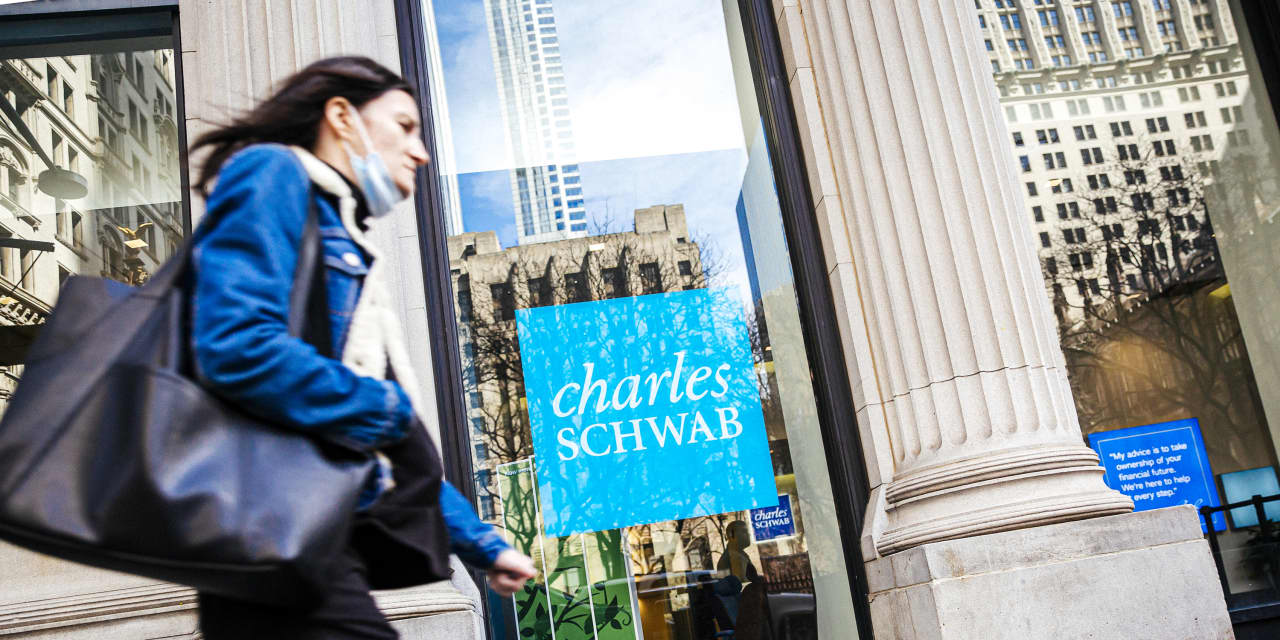Charles
Schwab’s
unrealized losses in a key part of its large bond portfolio widened in the third quarter to $19.4 billion as interest rates rose. Investors should pay attention.
The losses expanded by $4 billion from the second quarter because of a sharp selloff in the bond market.
The paper losses of $19.4 billion are in a portfolio of U.S. agency mortgage securities with a face value of $162 billion, according to the company’s 10-Q report released late Wednesday (Schwab doesn’t disclose the market value of that portfolio in its earnings reports.)
For accounting purposes, the portfolio is classified as held to maturity. That means Schwab (ticker: SCHW) doesn’t plan to sell these securities before they mature and, in turn, won’t realize the losses—a point Schwab emphasizes.
Because of its held-to-maturity, or HTM, classification, unrealized losses on this portfolio have no direct impact on Schwab’s financial strength. Any paper losses in HTM bond portfolios don’t depress the equity capital of financial companies, based on accounting rules.
There were $173 billion (face value) of U.S. agency mortgage securities in the Schwab HTM portfolio at the end of 2022 and about 70% of it consisted of mortgage securities with a maturity of longer than 10 years, according to Schwab’s 10-K report. Most of the rest of the HTM portfolio had maturities of five to 10 years. The available for sale portfolio had a shorter average maturity with nearly 40% of the bonds maturing in 10 years or more.
Investors, though, are focusing on these losses: Schwab stock has slid about 35% in 2023. The
Financial Select Sector SPDR ETF
(XLF), a broad measure of financial stocks, is about flat in 2023.
One reason the losses matter for investors is that while they are unrealized, they are still real. Another is they represent a missed investing opportunity for Schwab and other financial firms. The low yield on HTM bond portfolios could weigh on the returns at Schwab and many banks for years. Schwab’s HTM portfolio has a yield of less than 2%. These firms are locked into the low yields these securities carry, rather than being able to put cash to work into higher-yielding instruments available currently.
It’s also worth noting the $19.4 billion of paper losses exceeded Schwab’s average tangible equity of $9.7 billion during the third quarter. That means if these losses were realized, Schwab would have ended the quarter with negative tangible equity, which is an important measure of financial strength for financial companies. The unrealized third-quarter bond losses in Schwab’s held-to-maturity portfolio are among the largest relative to capital among big financial institutions.
Some analysts, however, apply a tax adjustment to the paper losses in the bond portfolio, which would reduce the $19.4 billion figure by about 25% to $15 billion. With that theoretical adjustment applied, Schwab said its banking units would have positive tangible equity.
Schwab told Barron’s that with its various sources of liquidity and healthy profitability, it won’t need to sell its bond portfolio of U.S. Treasury and agency securities before they mature—in turn, preventing the recent paper losses from ever being realized. As the bonds move toward maturity, the losses will melt away. The company also points to its earnings, which totaled $4.8 billion after taxes in the first three quarters of 2023.
“Accounting convention requires companies to ‘mark’ securities investments to market meaning these marks are not realized unless a security is sold prior to maturity,” Schwab said in a statement.
“Given our ongoing significant access to diversified sources of liquidity, the composition of our deposit base (sourced from 35MM accounts, with nearly 90% of balances under the FDIC insurance limits) and our high levels of profitability (>40% adjusted pretax margins leads most financials), there is a near-zero chance that Schwab would need to sell any of its investment securities prior to maturity—especially the HTM portfolio,” the statement said.
The company’s adjusted earnings per share are down 13% in through the first nine months of 2023, with third-quarter profits falling to 77 cents a share, a 30% decline from the year-earlier period.
Despite this year’s decline in both earnings and the stock, Schwab remains popular with Wall Street analysts. Twenty of the 25 analysts tracked by Bloomberg have a Buy or equivalent rating on the stock.
A figure that might comfort investors is Schwab averaged $28.3 billion of total common equity in the third quarter. Tangible equity—which averaged $9.7 billion in the quarter—is lower. It is a more conservative measure of shareholder equity, and excludes goodwill and other intangible assets stemming in part from acquisitions.
Clearly, the accounting for bond portfolios at Schwab and other financial companies is complex. Bank bond portfolios—generally consisting of risk-free Treasuries and low-risk agency mortgage securities—are held in two buckets that are subject to different accounting treatment.
Any paper losses on bond portfolios classified as available for sale generally need to be reflected in equity capital—unlike held-to-maturity bonds. For Schwab, the unrealized losses on its $122 billion available-for-sale portfolio totaled $11.8 billion on Sept. 30.
Schwab finances its bond portfolio with a mix of funding sources, including money in client cash sweep accounts now paying 0.45%.
Schwab has seen a significant outflow of deposits in the past year as its brokerage customers moved into higher-yielding cash alternatives, such as money-market funds now yielding over 5%. Schwab’s deposit base fell 30% in the past year to $291 billion.
But Peter Crawford, Schwab’s chief financial officer, said on the company’s conference call last month that “outflows are easing and we’re getting closer to the return of sweep cash growth.”
One risk at Schwab is that deposit outflows reaccelerate if short-term interest rates remain higher for longer, possibly forcing the bank to rely on higher-cost funding sources. Another risk is the company boosts its cash sweep rate from just 0.45%, which would cut into its interest margins. Brokerage clients at Schwab rival Fidelity Investments can earn money-market fund yields of 5% on their sweep accounts.
Schwab, however, said on its October conference call that it sees higher interest margins next year.
These big bond portfolio paper losses reflect the impact of the rapid rise in interest rates since last year. (Bond prices and yields move inversely.) Schwab, like many big banks, invested money from rising customer deposits in Treasury and agency debt securities in 2020 and 2021 at historically low yields. For Schwab’s total bond portfolio of about $285 billion, the average portfolio yield is only 2%—considerably below current market interest rates in the 4.5% to 6% range.
Among big banks,
Bank of America
(BAC) has the largest paper loss in its held-to-maturity portfolio at $131 billion on Sept. 30. The loss at
JPMorgan Chase
(JPM) is about $40 billion. Both Bank of America and JPMorgan have a lot more tangible common equity than Schwab, with JPMorgan holding more than $200 billion. Bank of America’s tangible common equity is about $186 billion.
Treasury rates are little changed since the end of the third quarter, meaning that unrealized bond losses at Schwab and banks likely haven’t changed much.
Schwab shares are up 0.3% to $54.32 Friday after falling 0.9% Thursday to $54.16.
Write to Andrew Bary at [email protected]
Read the full article here











